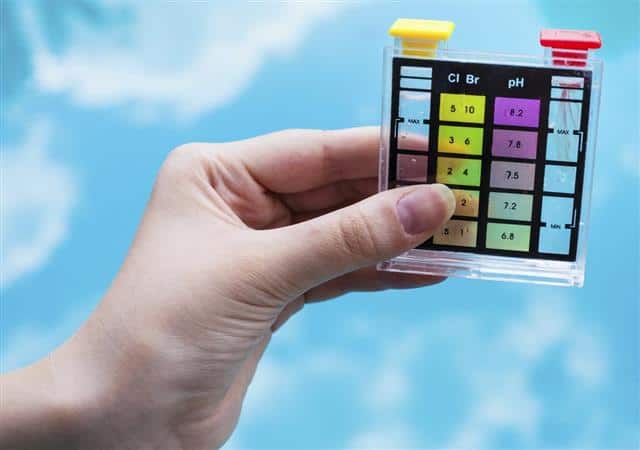
Maintaining the proper chemical balance in your swimming pool not only keeps the water sparkling clean, it also helps protect your pump, heater, and other pool equipment from damage, and can assist in keeping your pool looking like new.
The pH level of pool water is a measure of its acidity. It ranges on a scale from 0 to 14, with a pH of 7.0 and below indicating the water is acidic. A pH of 8.0 mean the water is basic or alkaline. The proper pool pH level is 7.4 to 7.6.
Top Reasons Proper pH is Important
We are going to discuss five of the main reasons on why keeping your pool water pH level between 7.4 to 7.6 is so important.
1. High pH inactivates chlorine
The closer your pH level goes near 8.0, the less effect your chlorine will have. You will find yourself constantly buying buckets of chlorine and still having water that is cloudy.
2. Low pH causes eye and skin irritation
Acidic water not only stings the eyes and nasal passages, it also strips the body of its natural oils often leaving the skin feeling dry and itchy, and can make your hair brittle. Unfortunately the same physical issues can arise if the pH level get too high as well.
3. Unbalanced pH can damage vinyl liners
Vinyl liners can actually grow and create unsightly wrinkles if you have a low pH level. On the other hand, a vinyl liner will age more rapidly and have to be replaced sooner if you pH is too high.
4. Low pH can lead to corrosion
Acidic pool water can begin to corrode everything from pumps and other mechanical equipment to ladders, and slide and diving board supports. The plaster in gunite pools can corrode if the pool water has a low pH.
5. High pH causes cloudy water
When the pH rises, many minerals often come out of the solution. This often leads to murky water and mineral deposits.
How to Maintain Proper pH
Its very important that you closely monitor your pool’s pH level daily using test strips. These test strips are great because they test free chlorine, bromine, alkalinity along pH. To test your water, go to an area away from the skimmer and the returns and hold a test strip 18 inches underwater for about 10 seconds. Remove the strip from the water but be careful not to shake the excess water off. Wait for the colors to fill in, then compare the strip to the color range on the product container.
How to Raise the pH Level in a Swimming Pool
If you find out your pH level is low, try adding sodium carbonate, commonly known as soda ash. You never want to add more the two pounds of soda ash per 10,000 gallons in your pool in any single treatment. You will want to first make sure that your pool pump is running so that it can circulate the water. After you have made sure the pool pump is running, you will want to start gradually pouring the soda ash into the water, starting from the deep end. After an hour has passed, you can check the pH levels again. If the pH level is still low, then repeat the process until you reach the proper pH levels.
Is it Safe to Swim in a Pool with High pH?
When your pH level in your pool exceeds 7.8 pH, your pool water is considered to have a high pH. A high pH does not play well with chlorine, which will make the chlorine no longer disinfect fully. There are several physical consequences of high pH for swimmers. Red irritable eyes, dry skin and wear and tear on goggles and bathing suits can often happen because of a high pH level.
Is it Safe to Swim in a Pool with Low pH?
When your pH level in your pool is below 7.0 pH, your pool water is considered to be acidic. Swimmers can feel immediate effects as the water will start to sting their eyes, nasal passages and will dry out their skin and hair, causing itching. Low pH, acidic water not only affect swimmers but can also corrode metal surfaces and pool accessories such as ladders, railings, lights, and other metals in your pool equipment.
Low pH can also lead to the deterioration of plaster, grout, stone, concrete, and tiling. Any vinyl surfaces will also become brittle, which can lead to cracks and tears. Lastly, if your pH level is low, it can make the chlorine less effective, leading to bacteria and algae build-up.
Conclusion
Well, when it comes to pool maintenance, keeping your pH level is very important. As many say, pH level is the foundation of your pool balance. As we covered there are many factors that can impact pool chemistry and with some practice and attention, you can ensure that your water remains safe for all of your pool equipment and perfect your pool users.

